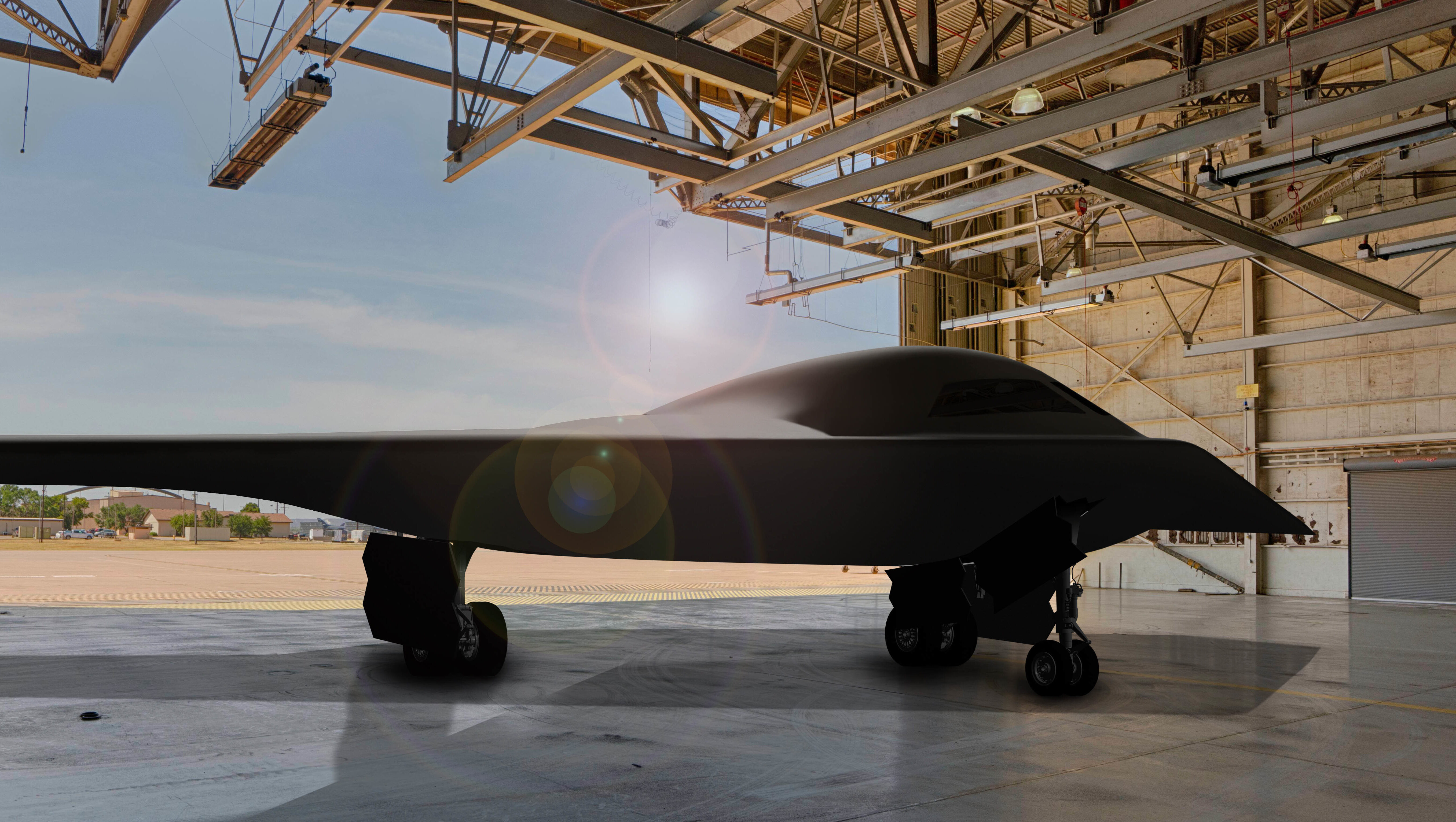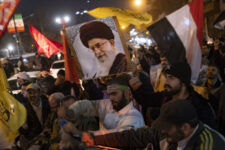
The B-21 Raider could be among the programs impacted by the current CR. (Air Force)
Once again, the US government is in the midst of a Continuing Resolution — a temporary funding mechanism used when Congress needs to avoid a government shutdown when it fails to successfully pass a budget on time. While unquestionably better than a shutdown, CRs aren’t harmless. The problem, as AEI scholar and Breaking Defense Board of Contributors member Mackenzie Eaglen points out, is that the military is starting to treat them as such. In the following op-ed, she lays out some key programs that will be hurt by the CR that haven’t gotten the attention they deserve.
Surprisingly blasé comments from the Navy suggest the service has so few new start programs or programs ramping up in quantity that its leaders are pretty relaxed about Congress’ 10-week spending freeze on all federal agencies. After all, defense officials have built the expectation of politicians not passing appropriations bills on time into their award plans for the year, pushing items to the right in the anticipation of inaction. We know this as fact: The Government Accountability Office recently confirmed as much with hard data.
But this casual acceptance of short-term continuing resolutions (CRs) having little impact sends confusing signals to Congress and perpetuates bad behavior. As the GAO has acknowledged, knowing how to operate within an inefficient system is not the same thing as operating efficiently. Continuing resolutions are riskily normalized, and this only makes more of them more likely.
How are they risky? Simply put, CRs add entirely avoidable burdens to stressed systems across the defense enterprise.
Start with the defense industrial base, which is already showing signs of strain from the national labor shortage, while industry is bracing for workers quitting due to the vaccine mandate.
At Bath Iron Works in Maine, the shipbuilder’s largest union said last week it “could lose about 30% of its membership—or more than 1,000 workers” over the administration’s vaccine mandate for federal contractors. The vaccination “problem” comes at “an especially bad time for the shipyard,” according to company leaders. Bath has “been making a major effort over the past year to speed up work, and get Navy destroyers completed more quickly.”
Expect similar workforce disruptions elsewhere, which will lead to shrinking an essential workforce already too small to meet customer demand. Hiring has been a persistent challenge for public and private Navy yards; Research by the GAO last year found that a “primary factor” in submarine and carrier maintenance delays at Navy shipyards is due to “workforce challenges such as not having enough people.”
Industries like shipbuilding, which demand significant touch labor by employees, are likely to be even more negatively affected when work is delayed due to a continuing resolution and employees don’t return. A spending stopgap measure not only imposes a hiring freeze on federal employees, but also leads to feast-and-famine contracting award cycles. This causes employers to ramp up hiring only to let those same employees go when there is a gap in production. Workflow fluctuations in the defense industrial base only aggravate hiring and retention of skilled labor.
Even though a short spending freeze seems mostly harmless, it is clear the US military cannot buy back time. The longer a CR drags on, the higher the likelihood of employee reductions, insufficient operating budgets, and underfunding existing programs the military needs to stay on schedule or accelerate.
No New Equipment Starts As Military Stares Down the ‘Terrible 20’s’
Another CR impact is the inability to start new programs, which also has a negative impact on staffing. While not perfect as a catch-all metric, reviewing delayed new starts is useful for tracking elements of where and how service modernization schedules and agendas are about to be impacted—and with them, the highly-skilled industrial base.
Managing multibillion dollar differences between a service’s FY21 budget and their FY22 request is no small task. More uncertainty often equates to more risk and the inability to plan ahead — whether that is ordering more parts, bringing on new labor or diversifying suppliers and vendors. Add to that sustained higher inflation and the possibility of re-negotiating costs in some contracts, and delays are inevitable.
Reports are already beginning to drop on how a 3-month CR will result in four to six month delays for select Army programs. It follows that the degree to which a program is impacted by CRs depends in no small part on its duration. So what programs and bills are vulnerable?
It would be convenient if the services maintained lists of such programs, updated with each annual budget request. The Army is the only service that does so for its R&D programs, and the Air Force and Navy should endeavor to implement the model in their budget materials next year.
For example, here are select programs from the Army’s list of new R&D efforts that will be negatively affected by a continuing resolution this year. [Note: The following links are to PDF files]
- $5 million for Long Range Maneuverable Fires (LRMF) Technology
- $11 million for applied research projects that focus directly on “capability enhancements” for soldiers and squads
- $18 million for All Domain Convergence and Advanced Technology
- $8 million for Mobile & Survivable Command Post (MASCP) Advanced Technology
- $16 million for Assured PNT Communications Advanced Technology
Even though the Army does not report a list of new procurement programs, the service’s budget materials will frequently highlight when a given program constitutes a new start. Here is a sample of Army procurement efforts slated to begin in this fiscal year, reflecting a range of cost and type:
- $35 million for Lower Tier Air and Missile Defense (LTAMDS)
- $287 million for Mobile Protected Firepower (MPF)
- $80 million for Vehicle Protection Systems (VPS)
- $24 million for new rifles as part of the Next Generation Squad Weapon program element
- $8 million for the Joint Tactical Ground Station (JTAGS) – Intel
- $2 million for the Enhanced Portable Inductive Artillery Fuze Setter (EPIAFS)
- $12 million for the Improved Forward Looking Infrared (IFLIR) B-Kit
- $60 million for the Counter-Small Unmanned Aircraft Systems (C-sUAS)
The Air Force reportedly requested 16 new start procurement programs in its FY22 budget, accounting for $2.3 billion of its budget request for the current fiscal year. This likely includes:
- $108 million for the B-21 Raider, Advance Procurement
- $10 million for the Advanced Trainer Replacement T-X
- $61 million for Distributed Aperture Infrared Countermeasures (HH-60W Modifications)
- $24 million for the SLC3S-A Enhancements effort (modifications to test new communications technologies)
- $15 million for the Massive Ordnance Penetrator (MOP)
- $11 million for the Ground Based Strategic Deterrent (GBSD)
- $161 million for the AGM-183A Air-Launched Rapid Response Weapon (ARRW)
Parsing through the Air Force’s research and development programs for new starts in the FY22 request is tricky. For example, the Air Force buckets hypersonic prototyping efforts under a single program element, but new projects are scheduled to be funded within that basket this fiscal year. Still, some Air Force new start R&D efforts are clear:
- $200 million for the Hypersonic Attack Cruise Missile (HACM)
- $42 million for the Tactical Multi-Mission Over the Horizon Radar (TACMOR), intended to provide “enhanced Air Domain Awareness in the INDOPACOM area of responsibility”
- $1 million for the Global Positioning System Interface Unit (GPS-IU) as part of the research and development effort supporting B-52 squadrons
- $37 million for a Spectrum Warfare Attack Capability project
- $7 million for a Command and Control, Incident Management, Emergency Response Application (C2IMERA)
- $40 million for Enhanced Anti-Jam Military Code Global Positioning System (M-Code EAJ) receivers
- $15 million for a Joint Transportation Management System (JTMS) aimed at transportation and transportation-related financial business process reform (with a range of other affiliated projects)
Obviously, the Navy, Marine Corps, and Space Force will not be exempt from the disruptions facing the Army and Air Force. The Space Force in particular faces extra hurdles as capabilities scheduled to transfer from the other services will fail to shift on time.
The big takeaway to all this is: while military officials are able to, on the surface-level, plan around a CR, it’s the Pentagon’s highest priorities that are going to suffer the most the longer this budget fight drags on.
The defense workforce that builds, supplies, services and maintains US military equipment is already under strain and too small. Hiring freezes, delayed work, and vaccine mandates all compound at the same time to produce a potentially consequential outlook at a delicate time.
Avoidable penalties from continuing resolutions on the military and defense and aerospace industrial workforces couldn’t come at a worse moment in time.
For Pentagon leaders to give the impression otherwise will only cause more heartburn later this year. And possibly make another CR more likely.
Mackenzie Eaglen is a defense expert at the American Enterprise Institute (AEI) and member of the Breaking Defense Board of Contributors.
Multi-ship amphib buy could net $900M in savings, say Navy, Marine Corps officials
Lawmakers gave the Navy authorities to ink a multi-ship amphib deal years ago, but the service has not utilized that power yet.


























